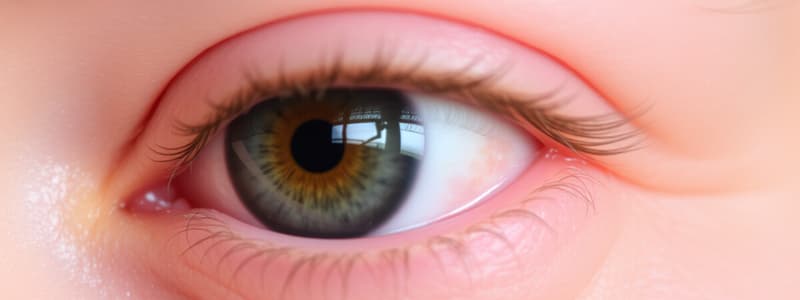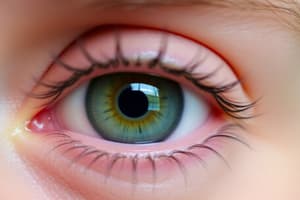Podcast
Questions and Answers
What is a common characteristic of myogenic ptosis?
What is a common characteristic of myogenic ptosis?
- Caused by a defect in the levator aponeurosis
- Can be resolved without medical intervention
- Results in drooping of the upper eyelid due to muscular tiredness (correct)
- Usually affects older individuals exclusively
Which of the following is NOT a classification of ptosis?
Which of the following is NOT a classification of ptosis?
- Hormonal (correct)
- Mechanical
- Neurogenic
- Myogenic
Which condition is specifically linked to drooping eyelids worsening throughout the day?
Which condition is specifically linked to drooping eyelids worsening throughout the day?
- Neurofibroma
- Third nerve palsy
- Myasthenia gravis (correct)
- Aponeurotic ptosis
Which symptom might be associated with Horner's syndrome?
Which symptom might be associated with Horner's syndrome?
What is the main cause of aponeurotic ptosis?
What is the main cause of aponeurotic ptosis?
Which muscle is primarily affected in myogenic ptosis?
Which muscle is primarily affected in myogenic ptosis?
Which condition is characterized by pseudoptosis due to dermatochalasis?
Which condition is characterized by pseudoptosis due to dermatochalasis?
Which of the following does NOT need to be ruled out in a case of ptosis?
Which of the following does NOT need to be ruled out in a case of ptosis?
What is a classic symptom of CN 3 palsy?
What is a classic symptom of CN 3 palsy?
What condition is suggested by progressive drooping of one or both eyelids or an inability to maintain upgaze?
What condition is suggested by progressive drooping of one or both eyelids or an inability to maintain upgaze?
What is the purpose of the ice pack test in diagnosing myasthenia gravis?
What is the purpose of the ice pack test in diagnosing myasthenia gravis?
What is a characteristic sign of Brow ptosis?
What is a characteristic sign of Brow ptosis?
What is a common cause of mechanical ptosis?
What is a common cause of mechanical ptosis?
In which condition does the ptotic lid appear higher than the normal lid during downgaze?
In which condition does the ptotic lid appear higher than the normal lid during downgaze?
What is the hallmark feature of involutional ptosis?
What is the hallmark feature of involutional ptosis?
What type of ectropion is primarily caused by ipsilateral facial nerve palsy?
What type of ectropion is primarily caused by ipsilateral facial nerve palsy?
What symptom is associated with entropion?
What symptom is associated with entropion?
What treatment option is recommended for cicatricial ectropion caused by chemical burns?
What treatment option is recommended for cicatricial ectropion caused by chemical burns?
The primary cause of congenital ptosis is often related to which of the following?
The primary cause of congenital ptosis is often related to which of the following?
What is considered mild ptosis in millimeters?
What is considered mild ptosis in millimeters?
What is the normal range for levator muscle function in millimeters?
What is the normal range for levator muscle function in millimeters?
Which condition is associated with fixed and dilated pupils?
Which condition is associated with fixed and dilated pupils?
What is the term for the inability to maintain the upper eyelid position when looking up for an extended period?
What is the term for the inability to maintain the upper eyelid position when looking up for an extended period?
In females, what is the normal palpebral fissure height in millimeters?
In females, what is the normal palpebral fissure height in millimeters?
What happens to the contralateral lid when the levator muscle of a ptotic lid is manually elevated?
What happens to the contralateral lid when the levator muscle of a ptotic lid is manually elevated?
What is the typical measurement range for an upper lid crease in millimeters?
What is the typical measurement range for an upper lid crease in millimeters?
Which phenomenon explains increased innervation to the normal levator muscle associated with unilateral ptosis?
Which phenomenon explains increased innervation to the normal levator muscle associated with unilateral ptosis?
What differentiates congenital ptosis from other forms of ptosis with respect to the upper lid crease?
What differentiates congenital ptosis from other forms of ptosis with respect to the upper lid crease?
If a patient experiences lid retraction when unilateral ptosis is present, what can be inferred?
If a patient experiences lid retraction when unilateral ptosis is present, what can be inferred?
Study Notes
Eyelid Dystrophies: Ptosis
- Abnormal low position of the upper eyelid in primary gaze, can be congenital or acquired.
- Types of ptosis:
- Neurogenic: requires ruling out neurological diseases.
- Myogenic: results from muscle innervation issues (e.g., Myasthenia Gravis).
- Aponeurotic: common in elderly due to aponeurosis weakness.
- Mechanical: caused by mass effects or scarring.
- Symptoms include drooping eyelid and visual loss, especially with reading.
- Signs indicating neurological conditions:
- Anisocoria: pupil size differences.
- Horner’s syndrome: miosis and ptosis.
- CN III Palsy: mydriasis present.
- Diplopia: muscle deviation leading to double vision.
Clinical Evaluation of Ptosis
- Evaluate ocular movements and measure eyelid margin distance (4-5 mm is normal).
- Assess levator function: normal (>15 mm), fair (5-11 mm), poor (<4 mm).
- Identify the presence of an upper lid crease: absent in congenital ptosis, increased in aponeurotic ptosis.
- Ask about symptom variability throughout the day, especially fatigue.
Associated Signs and Conditions
- Horner’s syndrome: characterized by ptosis, miosis, and anhidrosis.
- Marcus Gunn Jaw Winking Syndrome: unilateral retraction of the ptotic lid during jaw movement.
- Mechanical ptosis: caused by conditions like dermatochalasis or tumors.
Pseudoptosis and Other Causes
- Pseudoptosis can arise from artificial eye issues or orbital volume deficits.
- Conditions like phthisis bulbi lead to severe ocular changes and functional loss.
Ectropion
- Ectropion is the eversion of the eyelid, commonly caused by aging changes and laxity.
- Types include involutional, cicatricial, and paralytic ectropion.
- Treatment options range from lubricants to surgical interventions depending on severity and cause.
Entropion
- Characterized by inward eyelid turning causing irritation and discomfort.
- Types include involutional and cicatricial; the latter may follow chemical injuries or trauma.
- Treatment involves botox injections, lubricants, and surgical correction.
Surgical Treatments
- Common surgical procedures for ptosis include levator resection, advancement, and brow suspension.
- For ectropion, surgical management may involve lateral tarsal strip procedures or skin grafts.
- Evaluate the condition thoroughly based on patient symptoms and eyelid function to decide on the appropriate intervention.
Studying That Suits You
Use AI to generate personalized quizzes and flashcards to suit your learning preferences.
Related Documents
Description
This quiz covers the various aspects of eyelid dystrophies, with a focus on ptosis. Learn about its classifications, symptoms, and underlying causes. Ideal for students and professionals in ophthalmology and related fields.



